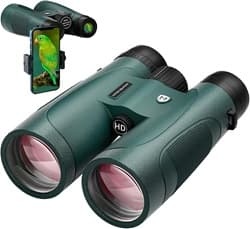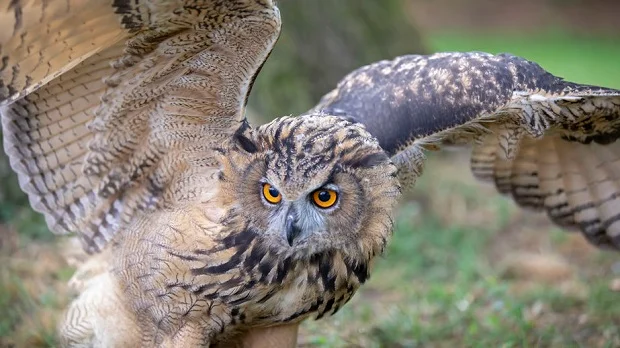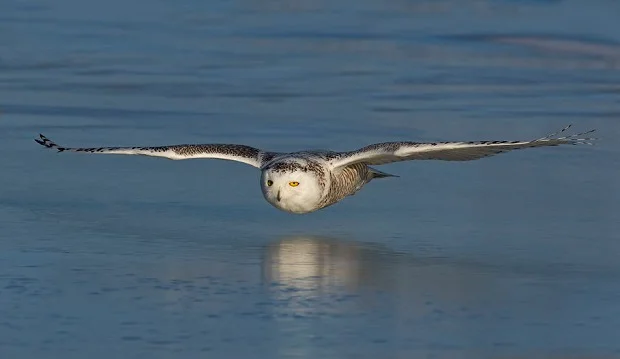How Do Owls Fly Silently?
Answer at a Glance: The awe-inspiring silence of the owl’s flight can be attributed to three remarkable physical attributes of its unique wing structure: the soft serrated edges of its leading wing, the flexible fringe on the trailing edge of the wing, and the soft downy feathers at the top of the wing.
The Bird’s Body Is Built for Flight
To better understand how an owl’s flight is quieter than that of other birds, it’s essential to know exactly how a bird flies.
The body of the bird is specifically designed for flight. For the bird to gain lift and maintain flight, it must be lightweight. This is mainly achieved through its hollow bone structure. Also, many of the bones in the bird’s skeletal system are fused, which helps to reduce weight and create a rigid support system. [1]
Another means of weight reduction is the reproductive organs, which are kept small until they are needed during the breeding season. [2]
The respiratory system of the bird is proportionately much larger than a mammal’s, about one-fifth of its body volume, which allows it to maintain the energy expended during flight. [3]
How Birds Fly

Its wings are its key component when it comes to flight.
The bird has strong breast muscles that it uses to push its wings downwards. With the wings fully extended, this motion pushes the air downwards, generating lift. The hinged wing then folds up on the upstroke. The action is similar to pumping your legs on a swing to gain momentum. The pressure is lower above the bird’s wing because the air travels faster above the wing than it does below. [4]
The air that rushes over the birds’ feathers creates turbulence, which in turn creates sound audible as it soars through the air.
Owl’s Unique Wing Structure Credited to Silent Flight
The noiseless flight of the owl can be credited to three physical attributes of its unique wing structure: the soft serrated edges of its leading wing, the flexible fringe on the trailing edge of the wing, and the soft downy feathers at the top of the wing.
The leading wing feathers, also called the stealth feathers, are serrated, which play a small part in the reduction of noise during flight, but it’s the fringe at the trailing edge of the wing that allows for the most significant noise reduction by breaking up the sound waves that are produced as the air rushes over the wings during flight. Additionally, the entire top of the owl’s wing is covered in a velvety, downy surface that acts as a sound absorber. These factors, working in tandem, alter the aerodynamics, resulting in the suppression of the sound that would typically be generated and radiated from the owl’s wings. [5]
Silent Flight: The Secret to Owl’s Predator Efficiency
A notable benefit of silent flight is the owl’s ability to approach prey undetected. The hearing of its prey, such as mice and voles, is acute between 2 and 10 kHz. The gliding motion and flapping of the owl’s wings generate noise at low frequencies below 2 kHz, making the owl silently invisible. [6]
The silent flight also benefits the owl while hunting because it allows it to hear more efficiently. Soundless flight and the position of its asymmetrical ears enable the owl to more accurately identify the source of a sound, which allows it to quickly and efficiently pinpoint the position of its prey. [7]
Owl Flight: A Potential Model for Quieter Commercial Flight
Understanding the exact mechanisms used in silent flight can serve as a model for any noise-reducing application where the surface is subjected to flow fields, such as aircraft and submarines, for which the military implications are obvious. Developing this technology could also help address the issues associated with commercial aircraft noise at major airports and the development of silent wind turbines. [8]
References
- [1][2][3] Stanford University – “Adaptations for Flight.”
- [4] University of Illinois Department of Physics – “How Do Birds Fly?”
- [5] Jaworski, J; American Physical Society – “Vortex Noise Reductions from a Flexible Fiber Model of Owl Down.”
- [6][7] Lilley, G. American Academy of Aeronautics and Astronautics, Inc. –
- “A Study of the Silent Flight of the Owl.”
- [8] Bachmann, T. Frontiers in Zoology; Morphometric characterisation of wing feathers of the barn owl Tyto alba pratincola and the pigeon Columba livia. 2007; 4:23
Related Products





